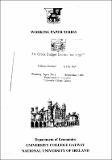Are Greek budget deficits 'too large'?

View/
Date
1995-09Author
Fountas, Stilianos
Metadata
Show full item recordUsage
This item's downloads: 1064 (view details)
Recommended Citation
Fountas, S. (1995). "Are Greek budget deficits 'too large'?" (Working Paper No. 001) Department of Economics, National University of Ireland, Galway.
Abstract
We use a residual-based cointegration test suggested by Gregory and Hansen
(1992) that allows for the determination of a structural break in the cointegrating
vector to test for the sustainability of Greek fiscal deficits over the 1958-1992
period. This relatively recent test leads to a different result from that derived
from standard Engle-Granger cointegration tests. The use of the conventional
Engle-Granger test implies no cointegration between tax revenues and interestinclusive
government expenditures. On the contrary, using the Gregory-Hansen
test we conclude that tax revenues and interest-inclusive government expenditures
are reintegrated and a structural break in the cointegrating vector took
place in either 1981 or 1983. Our result of cointegration with a structural
break is consistent with a strict interpretation of the government's intertemporal
budget constraint since it implies a zero discounted value of the public debt.
However, since the cointegration-regression slope parameter is significantly less
than one (when tax revenues are regressed on expenditure), the undiscounted
value of the public debt is different from zero. This means that the government
has incentives to default on its debt and, therefore, Greek budget deficit policy
is not sustainable.

